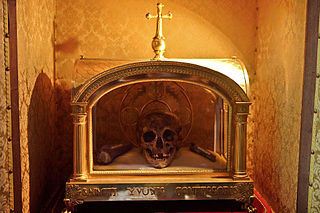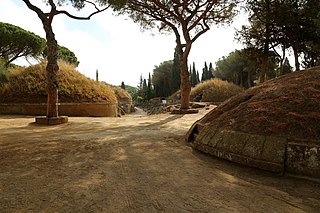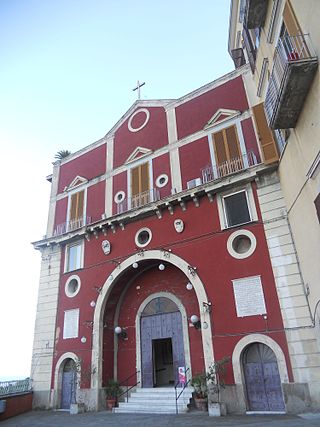
Publius Vergilius Maro, usually called Virgil or Vergil in English, was an ancient Roman poet of the Augustan period. He composed three of the most famous poems in Latin literature: the Eclogues, the Georgics, and the epic Aeneid. A number of minor poems, collected in the Appendix Vergiliana, were attributed to him in ancient times, but modern scholars consider his authorship of these poems to be dubious.

In religion, a relic is an object or article of religious significance from the past. It usually consists of the physical remains or personal effects of a saint or other person preserved for the purpose of veneration as a tangible memorial. Relics are an important aspect of some forms of Buddhism, Christianity, Islam, shamanism, and many other religions. Relic derives from the Latin reliquiae, meaning "remains", and a form of the Latin verb relinquere, to "leave behind, or abandon". A reliquary is a shrine that houses one or more religious relics.

The Sanctuary of Saint Michael the Archangel is a Roman Catholic shrine on Mount Gargano, Italy, part of the commune of Monte Sant'Angelo, in the province of Foggia, northern Apulia. It has the dignity of a minor basilica.

The Crypta Neapolitana is an ancient Roman road tunnel near Naples, Italy. It was built in 37 BC and is over 700 metres long.

Tarquinia, formerly Corneto, is an old city in the province of Viterbo, Lazio, Central Italy, known chiefly for its ancient Etruscan tombs in the widespread necropoleis, or cemeteries, for which it was awarded UNESCO World Heritage status.

Cerveteri is a town and comune of northern Lazio in the region of the Metropolitan City of Rome. Known by the ancient Romans as Caere, and previously by the Etruscans as Caisra or Cisra, and as Agylla by the Greeks, its modern name derives from Caere Vetus used in the 13th century to distinguish it from Caere Novum.

The Parish Basilica of Santa Maria del Popolo is a titular church and a minor basilica in Rome run by the Augustinian order. It stands on the north side of Piazza del Popolo, one of the most famous squares in the city. The church is hemmed in between the Pincian Hill and Porta del Popolo, one of the gates in the Aurelian Wall as well as the starting point of Via Flaminia, the most important route from the north. Its location made the basilica the first church for the majority of travellers entering the city. The church contains works by several famous artists, such as Raphael, Gian Lorenzo Bernini, Caravaggio, Alessandro Algardi, Pinturicchio, Andrea Bregno, Guillaume de Marcillat and Donato Bramante.

Giugliano in Campania, also known simply as Giugliano, is a city and comune (municipality) in the Metropolitan City of Naples, Campania, Italy. A suburb of Naples, as of 2017, it had some 124,000 inhabitants, making it the most populated Italian city that is not a provincial capital.

Castel dell'Ovo is a seafront castle in Naples, located on the former island of Megaride, now a peninsula, on the Gulf of Naples in Italy. The castle's name comes from a legend about the Roman poet Virgil, who had a reputation in the Middle Ages as a great sorcerer and predictor of the future. In the legend, Virgil put a magical egg into the foundations to support the fortifications. It remains there along with his bones, and had this egg been broken, the castle would have been destroyed and a series of disastrous events for Naples would have followed. The castle is located between the districts of San Ferdinando and Chiaia, facing Mergellina across the sea.

A canonical coronation is a pious institutional act of the pope, duly expressed in a formal decree of a papal bull, in which the pope bestows the pontifical right to impose an ornamental crown, a diadem or an aureole to an image of Christ, Mary or Joseph that is widely venerated in a particular diocese or locality.

Parco Vergiliano is a public park in Naples, southern Italy. It is located directly across from the Mergellina railway station and in back of the church of Santa Maria di Piedigrotta.

Saint Anthimus of Rome, or Sant'Antimo in Italian, is a Christian saint. His life is largely composed of legend. He is said to have been born in Bithynia. A Christian priest, he was imprisoned for his beliefs at the time of the Emperors Diocletian and Maximian. His feast day is May 11.
Trofimena is a female saint canonised in the Roman Catholic Church. Originally from the town of Patti in Sicily, the relics of Trofimena are venerated in the basilica in the town of Minori, Italy on the coast of Amalfi, southern Italy.

The Royal Palace of Portici is a former royal palace in Portici, Southeast of Naples along the coast, in the region of Campania, Italy. Today it is the home of the Orto Botanico di Portici, a botanical garden operated by the University of Naples Federico II. These gardens were once part of the large royal estate that included an English garden, a zoo and formal parterres.

The Gaudo Culture is an Eneolithic culture from Southern Italy, primarily in the region of Campania, active at the end of the 4th millennium BC, whose typesite necropolis is located near Paestum, not far from the mouth of the river Sele. Its name comes from the Spina-Gaudo necropolis.

The Cumaean Sibyl was the priestess presiding over the Apollonian oracle at Cumae, a Greek colony near Naples, Italy. The word sibyl comes from the ancient Greek word sibylla, meaning prophetess. There were many sibyls throughout the ancient world. Because of the importance of the Cumaean Sibyl in the legends of early Rome as codified in Virgil's Aeneid VI, and because of her proximity to Rome, the Cumaean Sibyl became the most famous among the Romans. The Erythraean Sibyl from modern-day Turkey was famed among Greeks, as was the oldest Hellenic oracle, the Sibyl of Dodona, dating to the second millennium BC according to Herodotus, favored in the east.

Virgil's Tomb is the title of at least three paintings completed by Joseph Wright of Derby between 1779 and 1785.

Santa Maria del Parto a Mergellina is a church located in the quartiere of Chiaia in Naples, Italy. The church is peculiarly perched on top of a private building and accessed by a stairway, placed behind a restaurant located in piazza Mergellina.

The Catacombs of Saint Gaudiosus are underground paleo-Christian burial sites, located in the northern area of the city of Naples.




















